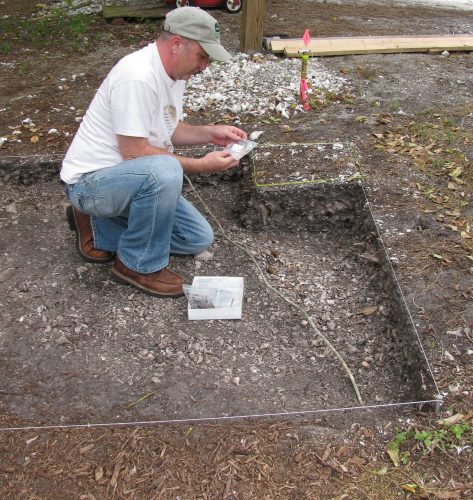In late December 2008, the Randell Research Center was offered an opportunity to examine Mound 5 of the Brown’s Mound Complex on property adjacent to the Randell Research Center.

Brown’s Mound 1, the largest mound on the Pineland site, is thought to have been surrounded by five other mounds, forming a six-mound “complex.” Mound 5 is indicated on a map drawn by archaeologist Frank Hamilton Cushing in 1895, before twentieth-century land modifications began. The map was discovered in an archive in California in 2002. A home was built on the mound in the 1920s, a common practice at the time. The house is still standing and is the property of popular author Randy Wayne White, who granted permission to dig.
After some initial complications, we proceeded with our investigation by opening a 2-x-2-meter excavation on the northeast side of the mound. Upper layers held a good deal of historic material in the form of glass spice bottles, majolica pottery, fine china, bottle glass, pearl buttons, animal bones, car parts, nails and other metal objects. The early twentieth century inhabitants of Pineland didn’t have trash pick-up any more than the Calusa did, so they disposed of their refuse in middens as well. After excavating to 40 cm from the surface (Level 83), what looked to be intact Calusa midden material began to be exposed. Dense shell deposits left from food and tool production, charcoal and fish bones in abundance, and a variety of indigenous pottery types have been found.
Initial examination of the pottery shows a diverse assemblage of types from Lake Okeechobee, Tampa Bay, and the St. Johns River basin, as well as locally produced wares. Locally produced pottery such as Sand-tempered Plain and Pineland Plain were not of the highest quality or durability due to the poor quality clays available. By the first century A.D. the Calusa began to seek out and acquire better quality pots from other parts of Florida. The wide variety of trade ware in Levels 83- 86 may suggest that these midden layers date to an exciting period of expanding Calusa influence in the Florida peninsula. We know that by the sixteenth century the Calusa had established wide-ranging contacts through their system of trade and tribute. Part of the story of Mound 5 may include evidence of how and when the Calusa came to rule much of South Florida.
At the end of last season, we had dug down 90 cm from the surface of Mound 5. We hope to be able to excavate our 2-x-2-meter square down to the base of the mound, which may be as far as two meters below the mound surface. We plan to continue our exploration of Mound 5 in November, when cooler temperatures and our dedicated volunteers begin to return to Pineland.
This article was taken from the Friends of the Randell Research Center Newsletter Vol 8, No. 3. September 2009.